I can say with a high degree of confidence that we have the most fun practicing warrior poses in my vinyasa flow classes. Warrior poses or Virabhadrasanas in Sanskrit, are some of the most widely known postures in the yoga world.
Virabhadrasanas are standing postures (an exception applies, which I will discuss later in this blog) with a wide stance and outstretched arms that develop strength, balance, flexibility and mental focus.
Let’s define Virabhadrasana – Vira means hero in Sanskrit, and Bhadra means blessing, auspicious or friend; and asana means posture. Virabhadrasanas can therefore be described as auspicious heroic postures. They are dynamic postures that make us feel fearless and powerful, graceful and elegant, tranquil and alert, humble and patient – all at the same time! Each warrior posture has its own specific quality that help us move forward in our individual yoga journeys.
Below, I dive deeper into Virabhadrasanas – how to practice them and what physical, mental and emotional benefits you can expect from a regular practice. As you read through this blog, consider which warrior you enjoy the most and which one you find challenging, and why that might be.
There are 5 standing and 1 reclining warrior poses that we regularly practice in my vinyasa flow and yin yoga classes.
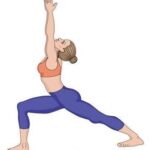
Warrior I (Virabhadrasana I)
How to practice: turn the right foot 90 degrees, left foot 45 degrees inwards, bend the front knee, make sure the ankle is right under the knee, square the hips towards the right with straight arms raised above the head, palms together above the head and softly gaze towards your palms. Hold for 3 – 5 deep breaths.
Benefits: strengthens your lower body, especially your hamstrings, feet, ankles, glutes and quadriceps. It also builds core strength by having the spine long and the chest lifted. Mentally, it promotes focus, concentration and body awareness. On an emotional level, Warrior I is a fiery pose of bravery, celebration and virtue.

Warrior II (Virabhadrasana II)
How to practice: turn right foot 90 degrees to the right, keep the left foot forward, bend the right knee, make sure the ankle is right under the knee, turn the hips slightly to the side and stretch the arms out parallel to the floor. Softly gaze past the right hand and focus on your breath. Hold for 3-5 breaths.
Benefits: Warrior 2 strengthens your body’s quads, adductors of the inner thighs, hamstrings and core muscles, as well as your arms, shoulders, upper back, hips and glutes. Mentally, this asana challenges us to find ease within effort and builds mental stamina, inner strength and concentration.
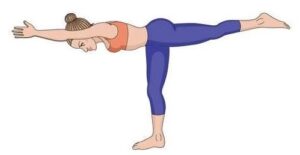
Warrior III (Virabhadrasana III)
How to practice: feet are hip-width apart and parallel to each other, hands on the waist, activate core and pelvic floor muscles, inhale and lift the right leg up behind you and as you do so, lean forward with straight arms reaching forward, palms are parallel to each other and gaze between the palms. Try to align the right leg and upper body parallel to the floor. Hold for 3-5 breaths.
Benefits: This Virabhadrasana creates muscular stability as you engage your core and stabilizer muscles, hamstrings, gluteus and spine. It also strengthens the shoulders, hamstrings, calves, and ankles. As you balance all your weight on one foot, you discover how to remain calm and cool under stress. Learning to balance on one foot requires inner strength, faith, courage and humility.

Humble Warrior (Baddha Virabhadrasana)
Humble Warrior is also known as Devotional or Bound Warrior or Virabhadra Mudra.
How to practice: (initial alignment is similar to Warrior II) turn the right foot 90 degrees to the right, keep the left foot forward, make sure the ankle is right under the knee, hips slightly to the side, hands on the waist and on exhale fold towards the bent right knee, interlink fingers behind you, lift up straight arms towards the ceiling and on exhale lower your head under the right knee. Hold for 3-5 breaths.
Benefits: this Virabhadrasana tones and strengthens your hamstrings, quadriceps, calves, abdomen, glutes and back while stretching and opening your shoulders, chest, arms and hips. On a mental level, it builds body-mind awareness and creates a sense of introspection and groundedness. Emotionally, this asana encourages vulnerability, humility and acceptance.
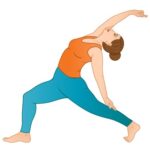
Reverse Warrior (Viparita Virabhadrasana)
Reverse Warrior is also known as Crescent Pose, Friendly Warrior, Peaceful Warrior or Proud Warrior.
How to practice: (initial alignment is similar to Warrior II) turn the right foot 90 degrees to the right, keep the left foot forward, bend the right knee and make sure the ankle is right under the knee, turn the hips slightly to the side, gently rest the left hand on the left leg, inhale and lift the right arm up above your head and softly gaze towards the right palm. Hold the pose for 3-5 breaths.
Benefits: this asana deeply stretches the side body, as well as the hips, spine, chest and inner thighs. It strengthens the abdominals, intercostal muscles, neck, arms and the psoas. Mentally, it calms the mind by increasing the flow of prana and blood and releases tension in the upper body. Emotionally, this Virabhadrasana offers strength, power, perseverance and self-esteem. It also promotes your ability to flow through life’s challenges with ease and grace.

Reclining Hero (Supta Virasana)
Reclining Hero is not acknowledged as a Virabhadrasana but a warrior pose nonetheless.
How to practice: start with sitting on your heels in the centre of your mat (thunderbolt or hero pose), slowly move the feet outwards so that the sitting bones connect with your mat, gently lean back and place both elbows behind you and slowly relax the arms next to the body and lie down on the mat, palms facing up. Hold the pose for 3-5 minutes. This warrior pose is unique in that it is practiced lying on the mat, and officially belongs to the practice of yin yoga. Supta Virasana may be challenging for most yoga practitioners. Take it at your own pace and level.
Benefits: stretches and strengthens the ankles, hip flexors, thighs, and knees, which can help to relieve sciatica and varicose veins. By opening up the chest, torso, and pelvic area, this asana increases flexibility in the spine and can help to alleviate back pain. Regular practice can help to improve posture by stretching and strengthening the muscles in the back, shoulders and chest. Emotionally this asana allows you to relax and surrender, making it an excellent way to unwind and reduce stress.
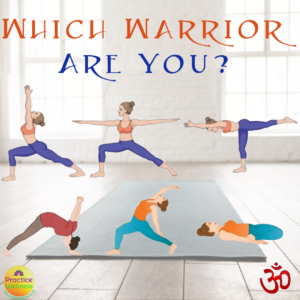
Which warrior pose expresses you the most? Which one challenges you? Which one will you try out next? Feel free to post your answers in the comment section below and ask me any questions you may have.
Side note: We are just ONE WEEK away from our 6-week immersion yoga course. As of now, there are 3 spaces left and you are welcome to join us if you are in Bath or surrounding area. And yes, you guessed it, we will be practicing Virabhadrasanas!
Click here for more information and book your spot now.
Have a great week – and a whole new wonderful month ahead!
Sossi

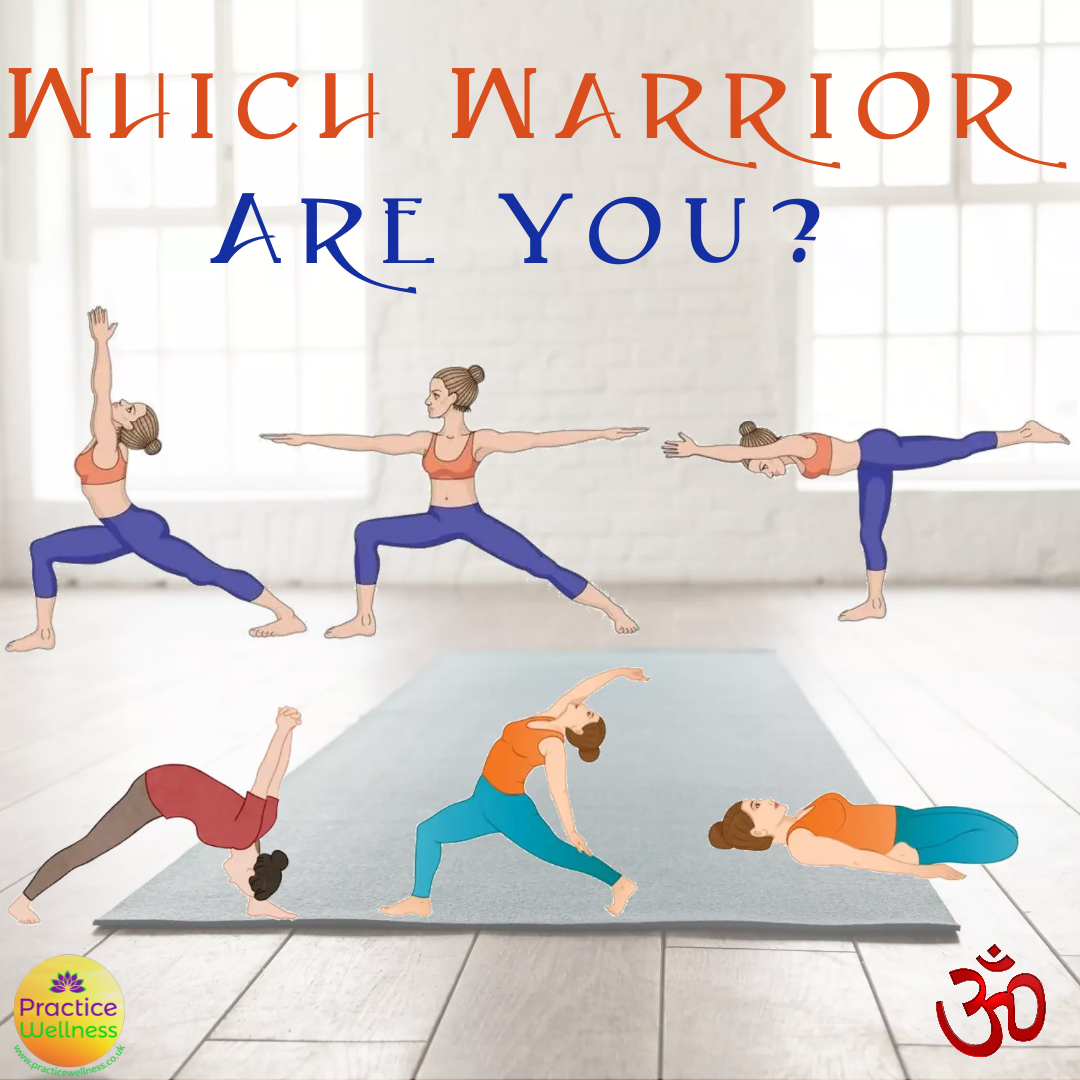

Hi Sossi
I think virabhadrasana 2 expresses more for me, 3 challengeges the most because of balance, and supra viirasana as always for me and this body presents a discomfort because of my body mechanicsa very modified version for me to look after my knees Practiced in a flowing sequence I really like the most
Lovely to hear from you Andy! Yes I get it, there is certain power from 2 and you can always do variations and modified versions with any asana. We will flow with virabhadrasanas soon again 🙂